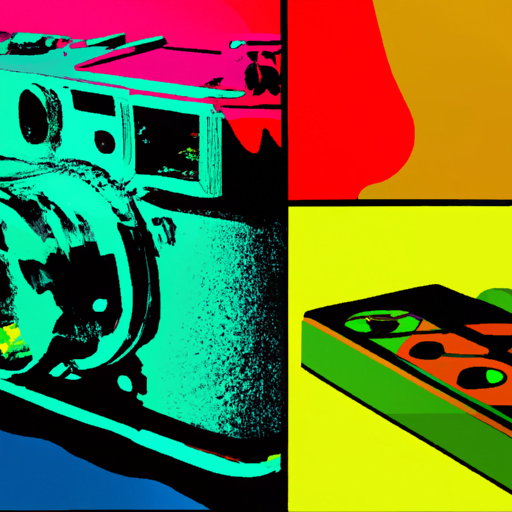-
Table of Contents
Exploring Retro-Futurism in Graphic Design
Graphic design is a constantly evolving field that draws inspiration from various sources. One such source that has gained popularity in recent years is retro-futurism. Retro-futurism is a design style that combines elements of the past with futuristic concepts, creating a unique and captivating visual aesthetic. In this article, we will delve into the world of retro-futurism in graphic design, exploring its origins, key characteristics, and its impact on contemporary design.
The Origins of Retro-Futurism
Retro-futurism emerged as a design movement in the mid-20th century, primarily influenced by the rapid technological advancements and space exploration of the time. It was a period of great optimism and excitement about the future, which was reflected in various art forms, including graphic design.
One of the earliest examples of retro-futurism can be traced back to the World’s Fair held in New York in 1939. The fair showcased a vision of the future, featuring streamlined architecture, futuristic transportation, and innovative technologies. This vision of the future heavily influenced graphic design during that era.
Another significant influence on retro-futurism was the Space Age of the 1950s and 1960s. The launch of the Soviet satellite Sputnik in 1957 and the subsequent space race between the United States and the Soviet Union captured the imagination of the public. Graphic designers began incorporating space-themed elements, such as rockets, flying saucers, and futuristic cityscapes, into their work.
Key Characteristics of Retro-Futurism
Retro-futurism is characterized by a unique blend of nostalgia and futuristic elements. It combines the aesthetics of the past with the imagination of the future, creating a visually striking and thought-provoking style. Here are some key characteristics of retro-futurism in graphic design:
- Streamlined Forms: Retro-futuristic designs often feature sleek and streamlined forms, inspired by the Art Deco movement of the early 20th century. These clean lines and geometric shapes give a sense of modernity and progress.
- Bright Colors: Bold and vibrant colors are commonly used in retro-futuristic designs to evoke a sense of optimism and excitement. Colors like electric blue, neon pink, and metallic silver are frequently seen in this style.
- Space and Technology: As retro-futurism is heavily influenced by the Space Age, space-themed elements and futuristic technologies are prevalent in this design style. Rockets, flying cars, robots, and other futuristic gadgets often make an appearance.
- Vintage Typography: Retro-futuristic designs often incorporate typography styles from the past, such as Art Deco or 1950s sci-fi movie titles. These vintage-inspired fonts add a nostalgic touch to the overall design.
- Collage and Montage: Retro-futurism embraces the use of collage and montage techniques, combining different elements from various sources to create a visually rich and layered composition.
Examples of Retro-Futurism in Graphic Design
Now that we have explored the characteristics of retro-futurism, let’s take a look at some notable examples of this design style:
1. The Jetsons
The animated television series “The Jetsons,” which aired in the 1960s, is a classic example of retro-futurism. The show depicted a futuristic world with flying cars, robot maids, and advanced technologies. The visual style of “The Jetsons” featured sleek and streamlined designs, vibrant colors, and space-age aesthetics.
2. The Works of Syd Mead
Syd Mead, a renowned concept artist and industrial designer, is known for his influential work in the field of retro-futurism. Mead’s designs have been featured in iconic films such as “Blade Runner” and “Tron.” His futuristic cityscapes, vehicles, and gadgets have become synonymous with the retro-futuristic aesthetic.
3. Vaporwave Art
Vaporwave is a subgenre of electronic music that emerged in the early 2010s. It is heavily influenced by retro-futurism and often features nostalgic imagery from the 1980s and 1990s. Vaporwave album covers and promotional artwork often incorporate glitch effects, neon colors, and retro computer graphics, creating a distinct retro-futuristic vibe.
The Impact of Retro-Futurism on Contemporary Design
Retro-futurism has had a significant impact on contemporary graphic design. Its unique blend of nostalgia and futuristic elements has captured the attention of designers and audiences alike. Here are some ways in which retro-futurism has influenced contemporary design:
- Revival of Vintage Aesthetics: Retro-futurism has sparked a revival of vintage aesthetics in graphic design. Designers are incorporating elements from the past, such as retro typography and color palettes, into their work to create a sense of nostalgia and evoke emotions.
- Exploration of Alternative Futures: Retro-futurism encourages designers to imagine alternative futures by combining elements from different time periods. This allows for creative and thought-provoking designs that challenge traditional notions of what the future should look like.
- Engaging and Memorable Designs: The visually striking nature of retro-futurism makes it highly engaging and memorable. Brands and businesses are leveraging this design style to create eye-catching advertisements and marketing materials that stand out from the crowd.
- Embracing Technology: Retro-futurism celebrates the potential of technology and its impact on society. By incorporating futuristic technologies and concepts into their designs, graphic designers are able to explore the possibilities of the future and inspire innovation.
Summary
Retro-futurism in graphic design is a captivating style that combines elements of the past with futuristic concepts. It emerged in the mid-20th century, influenced by the rapid technological advancements and space exploration of the time. Retro-futurism is characterized by streamlined forms, bright colors, space and technology themes, vintage typography, and collage techniques. Notable examples of retro-futurism include “The Jetsons,” the works of Syd Mead, and vaporwave art. Retro-futurism has had a significant impact on contemporary design, leading to a revival of vintage aesthetics, exploration of alternative futures, engaging and memorable designs, and an embrace of technology. As the world continues to evolve, retro-futurism will likely remain a source of inspiration for graphic designers, pushing the boundaries of creativity and imagination.
